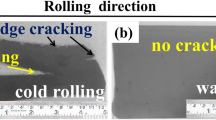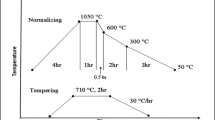Conclusions
-
1.
With the addition of 0.001–0.0074% Te, the notch toughness (in the range of +20 to −100°) of samples of type 1 is 0.25–0.30 MJ/m2 higher than for the steel without tellurium.
-
2.
The higher notch toughness resulting from the addition of tellurium is due to the increase in the work of crack initiation.
-
3.
With 0.019% Te the notch toughness and work of crack initiation decline.
-
4.
The quantity of ductile components in the fracture and the work of crack propagation are independent of the tellurium content at testing temperatures from 20 to −100°.
-
5.
Despite the substantial cost of tellurium it is expedient to add tellurium to structural steels because of their high notch toughness at low temperatures.
Similar content being viewed by others
Literature cited
A. Massip and L. Meyer, Thyssen. Techn. Ber.,10, No. 2, 26 (1978).
Sadayuki Nakamura, J. Iron Steel Inst. Jpn.,66, No. 4, 531 (1980).
Additional information
I. P. Bardin Central Scientific-Research Institute of Ferrous Metallurgy. Translated from Metallovedenic i Termicheskaya Obrabotka Metallov, No. 3, pp. 21–22, March, 1983.
Rights and permissions
About this article
Cite this article
Popova, L.V., Lebedev, D.V. & Nasibov, A.G. Properties of steel 16G2AF with microadditions of tellurium. Met Sci Heat Treat 25, 184–186 (1983). https://doi.org/10.1007/BF00805969
Issue Date:
DOI: https://doi.org/10.1007/BF00805969




